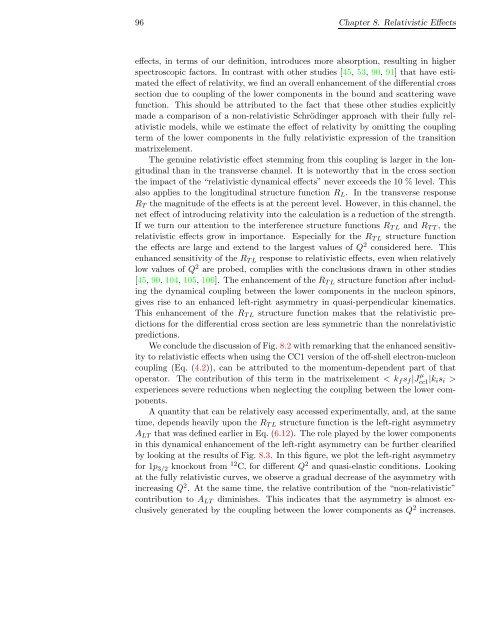Download Thesis in Pdf Format - Theoretical Nuclear Physics and ...
Download Thesis in Pdf Format - Theoretical Nuclear Physics and ...
Download Thesis in Pdf Format - Theoretical Nuclear Physics and ...
Create successful ePaper yourself
Turn your PDF publications into a flip-book with our unique Google optimized e-Paper software.
96 Chapter 8. Relativistic Effects<br />
effects, <strong>in</strong> terms of our def<strong>in</strong>ition, <strong>in</strong>troduces more absorption, result<strong>in</strong>g <strong>in</strong> higher<br />
spectroscopic factors. In contrast with other studies [45, 53, 90, 91] that have estimated<br />
the effect of relativity, we f<strong>in</strong>d an overall enhancement of the differential cross<br />
section due to coupl<strong>in</strong>g of the lower components <strong>in</strong> the bound <strong>and</strong> scatter<strong>in</strong>g wave<br />
function. This should be attributed to the fact that these other studies explicitly<br />
made a comparison of a non-relativistic Schröd<strong>in</strong>ger approach with their fully relativistic<br />
models, while we estimate the effect of relativity by omitt<strong>in</strong>g the coupl<strong>in</strong>g<br />
term of the lower components <strong>in</strong> the fully relativistic expression of the transition<br />
matrixelement.<br />
The genu<strong>in</strong>e relativistic effect stemm<strong>in</strong>g from this coupl<strong>in</strong>g is larger <strong>in</strong> the longitud<strong>in</strong>al<br />
than <strong>in</strong> the transverse channel. It is noteworthy that <strong>in</strong> the cross section<br />
the impact of the “relativistic dynamical effects” never exceeds the 10 % level. This<br />
also applies to the longitud<strong>in</strong>al structure function R L . In the transverse response<br />
R T the magnitude of the effects is at the percent level. However, <strong>in</strong> this channel, the<br />
net effect of <strong>in</strong>troduc<strong>in</strong>g relativity <strong>in</strong>to the calculation is a reduction of the strength.<br />
If we turn our attention to the <strong>in</strong>terference structure functions R T L <strong>and</strong> R T T , the<br />
relativistic effects grow <strong>in</strong> importance. Especially for the R T L structure function<br />
the effects are large <strong>and</strong> extend to the largest values of Q 2 considered here. This<br />
enhanced sensitivity of the R T L response to relativistic effects, even when relatively<br />
low values of Q 2 are probed, complies with the conclusions drawn <strong>in</strong> other studies<br />
[45, 90, 104, 105, 106]. The enhancement of the R T L structure function after <strong>in</strong>clud<strong>in</strong>g<br />
the dynamical coupl<strong>in</strong>g between the lower components <strong>in</strong> the nucleon sp<strong>in</strong>ors,<br />
gives rise to an enhanced left-right asymmetry <strong>in</strong> quasi-perpendicular k<strong>in</strong>ematics.<br />
This enhancement of the R T L structure function makes that the relativistic predictions<br />
for the differential cross section are less symmetric than the nonrelativistic<br />
predictions.<br />
We conclude the discussion of Fig. 8.2 with remark<strong>in</strong>g that the enhanced sensitivity<br />
to relativistic effects when us<strong>in</strong>g the CC1 version of the off-shell electron-nucleon<br />
coupl<strong>in</strong>g (Eq. (4.2)), can be attributed to the momentum-dependent part of that<br />
operator. The contribution of this term <strong>in</strong> the matrixelement < k f s f |J µ cc1 |k is i ><br />
experiences severe reductions when neglect<strong>in</strong>g the coupl<strong>in</strong>g between the lower components.<br />
A quantity that can be relatively easy accessed experimentally, <strong>and</strong>, at the same<br />
time, depends heavily upon the R T L structure function is the left-right asymmetry<br />
A LT that was def<strong>in</strong>ed earlier <strong>in</strong> Eq. (6.12). The role played by the lower components<br />
<strong>in</strong> this dynamical enhancement of the left-right asymmetry can be further clearified<br />
by look<strong>in</strong>g at the results of Fig. 8.3. In this figure, we plot the left-right asymmetry<br />
for 1p 3/2 knockout from 12 C, for different Q 2 <strong>and</strong> quasi-elastic conditions. Look<strong>in</strong>g<br />
at the fully relativistic curves, we observe a gradual decrease of the asymmetry with<br />
<strong>in</strong>creas<strong>in</strong>g Q 2 . At the same time, the relative contribution of the “non-relativistic”<br />
contribution to A LT dim<strong>in</strong>ishes. This <strong>in</strong>dicates that the asymmetry is almost exclusively<br />
generated by the coupl<strong>in</strong>g between the lower components as Q 2 <strong>in</strong>creases.















